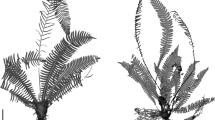Abstract
The distinctive spores produced byLophosoria, an extant monotypic fern, are examined ultrastructurally and correlated with the sporoderm of fossilCyatheacidites. The morphological and ultrastructural similarity of the two taxa provide additional information that can be used to trace the evolutionary history of this spore type.
Similar content being viewed by others
References
Archangelsky, S., 1972: Esporas de la Formación Río Turbio (Eoceno). Provincia de Santa Cruez. — Rev. Mus. La Plata, n.s., Paleont.6, 65–100.
Archangelsky, S., Gamerro, J. C., 1965: Estudio palinológico de la Formación Baqueró (Cretácico), Provincia de Santa Cruez. — Ameghiniana4, 159–167.
Bower, F. O., 1912: Studies in the phylogeny of theFilicales. II.Lophosoria and its relation to theCyatheoideae and other ferns. — Ann. Bot. (London)26, 269–323.
- 1926: The Ferns (Filicales). Vol. II. The Eusporangiate and Other Relatively Primitive Ferns. — Cambridge University Press.
Cookson, I. C., 1947: Plant microfossils from the lignites of the Kerguelen Archipelago. — B.A.N.Z.A.R.E. Repts., ser. A,2, 129–142.
—, 1957: On some Australian Tertiary spores and pollen grains that extend the geological and geographical distribution of living genera. — Proc. R. Soc. Victoria69, 41–53.
—, Cranwell, L. M., 1967: Lower Tertiary microplankton, spores and pollen grains from southernmost Chile. — Micropaleontol.13, 204–216.
Erdtman, G., 1957: On the risk of overstressing the denomination of fossil spores as illustrated by a paper on the former distribution ofLophosoria (“Cyathea annulata”). — Svensk Bot. Tidskr.51, 611–613.
Fasola, A., 1969: Estudio palinológico de la Formación Loreto (Terciario Medio), Provincia de Magallanes, Chile. — Ameghiniana6, 3–49.
Gastony, G. J., 1974: Spore morphology in theCyatheaceae. I. The perine and sporangial capacity: general considerations. — Amer. J. Bot.61, 672–680.
—, 1981: Spore morphology in theDicksoniaceae. I. The generaCystodium, Thyrsopteris, andCulcita. — Amer. J. Bot.68, 808–819.
—, 1982: Spore morphology in theDicksoniaceae. II. The genusCibotium. — Canad. J. Bot.60, 955–972.
—, Tryon, R. M., 1976: Spore morphology in theCyatheaceae. II. The generaLophosoria, Metaxya, Sphaeropteris, Alsophila, andNephelea. — Amer. J. Bot.63, 738–758.
Lucansky, T. W., 1974: Comparative studies of the nodal and vascular anatomy of the neotropicalCyatheaceae. I.Metaxya andLophosoria. — Amer. J. Bot.61, 464–471.
—, 1982: Anatomical studies of the neotropicalCyatheaceae. II.Metaxya andLophosoria. — Amer. Fern J.72, 19–29.
Lugardon, B., 1971: Contribution à la connaissance de la morphogenèse et de la structure des parois sporales chez les Filicinées isosporées. — Thèse Univ. P. Sabatier, Toulouse.
Nishida, H., 1982:Lophosoriorhachis japonica n. gen. et sp., from the lower Cretaceous of Choshi, Chiba Prefecture, Japan. — Palaeontographica181 B, 118–122.
Pichi-Sermolli, R. E. G., 1970: Fragmenta pteridologiae, II. — Webbia24, 699–722.
—, 1977: Tentamen pteridophytorum genera in taxonomicum ordinem redigendi. — Webbia31, 313–512.
Seward, A. C., Conway, V., 1934: A phytogeographical problem: fossil plants from the Kerguelen Archipelago. — Ann. Bot. (London)48, 715–741.
Skottsberg, C., 1956: Derivation of the flora and fauna of Juan Fernandez and Easter Island. — InSkottsberg, C., (Ed.): The Natural History of Juan Fernandez and Easter Island, vol.I, part III, pp. 193–438. — Uppsala: Almquist & Wiksell.
Stover, L. E., Partridge, L. D., 1973: Tertiary and late Cretaceous spores and pollen from the Gippsland Basin, Southeastern Australia. — Proc. R. Soc. Victoria85, 237–286.
Tryon, R. M., 1970: The classification of theCyatheaceae. — Contr. Gray Herb. Harv. Univ.200, 3–53.
—, Tryon, A. F., 1982; Ferns and Allied Plants. With Special Reference to Tropical America. — New York, Heidelberg, Berlin: Springer.
Wachtel, A. W., 1980: Thermoplastic wax for mounting SEM specimens. — Scanning3, 302.
Walker, T. G., 1966: A cytotaxonomic survey of thePteridophyta of Jamaica. — Trans. R. Soc. Edinburgh66, 169–237.
Author information
Authors and Affiliations
Rights and permissions
About this article
Cite this article
Kurmann, M.H., Taylor, T.N. Sporoderm ultrastructure ofLophosoria andCyatheacidites (Filicopsida): Systematic and evolutionary implications. Pl Syst Evol 157, 85–94 (1987). https://doi.org/10.1007/BF00939183
Received:
Issue Date:
DOI: https://doi.org/10.1007/BF00939183




